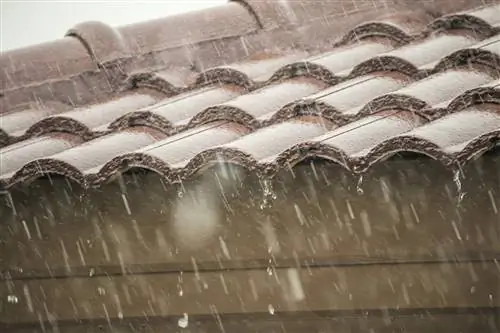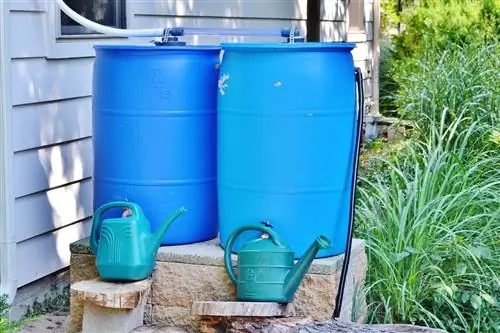- Author admin [email protected].
- Public 2023-12-17 03:39.
- Last modified 2025-01-24 12:45.
Whether you are a homeowner or a tenant: In Germany, every private household has to pay the so-called rainwater fee, also popularly known as the rain fee. Who has to pay this fee, how is it calculated and can it possibly be avoided?
Definition
The rainwater fee is part of the wastewater fee, which is split into wastewater, freshwater and rainwater and is calculated and collected separately. This fee is also popularly referred to as the “rain tax” because it is levied on all rainwater that is drained into the sewer system. Therefore, only built-up and sealed property areas are included in the calculation.
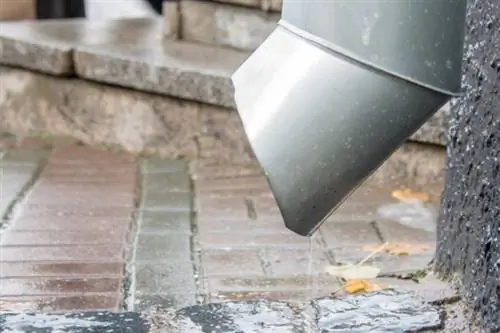
Note:
Unsealed or poorly sealed areas, however, remain tax-free. Here the rainwater does not flow into the public sewage system, but rather seeps into the ground.
Who pays?
In Germany, every private household - including homeowners and apartment owners - as well as every company and public institution (i.e. municipal and state companies and authorities) has to pay the rainwater fee. Landlords are allowed to pass the fee on to the tenants via the operating costs, provided that a corresponding agreement is set out in the rental agreement.
Note:
Contrary to some reports to the contrary, owners and landlords are not allowed to deduct the rainwater fee from their taxes. This only applies to the cleaning and maintenance of the sewage pipes on your property.
Maturity
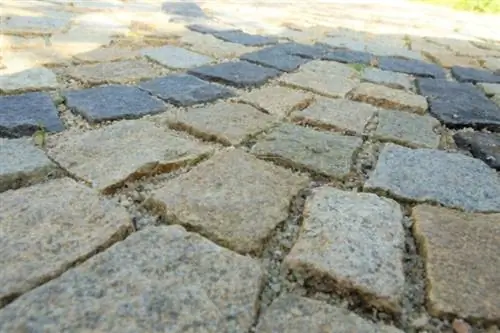
As a rule, the rainwater fee is due once a year, although the specific amount depends on the sealed area of your property. The larger the sealed area, which also includes the roof, the higher the amount to be paid. On average, the rain fee is around 150 to 200 EUR annually.
Calculation
Calculating the rainfall fee is complicated and should therefore be carried out by someone with appropriate specialist knowledge. In many cases, however, the calculation is already done automatically by the municipalities, which calculate the proportion of paved and therefore fee-relevant areas based on aerial photographs.
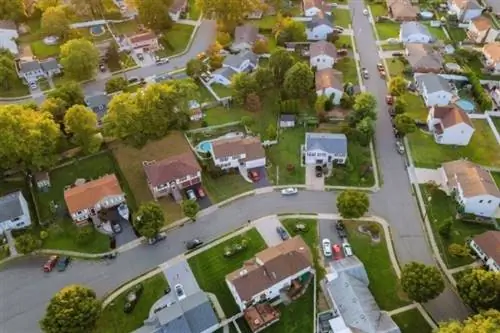
Consider paved areas
- Roof surfaces (except green roofs)
- paved areas and paths
- paved driveways and parking spaces (including carports)
- Terraces
- gravel areas
When added together, these areas form the basis for the specific amount of the rainwater fee,whereby the municipalities charge between EUR 0.70 and EUR 2.00 per square meterThis can be enormous financial burden differences, as our sample calculation for a single-family house with 100 m2roof area and 54 m2 paved and paved areas shows:
Tip:
The size of the sealed areas is in most cases rounded down to a full 10m2, in our case to 150m2.
| City | Precipitation water fee rate | Total costs |
|---|---|---|
| Frankfurt | 0, 50 EUR/m2 | 75.00 EUR |
| Stuttgart | 0, 68 EUR/m2 | 102.00 EUR |
| Hamburg | 0, 73 EUR/m2 | 109, 50EUR |
| Cologne | 1, 27 EUR/m2 | 190, 50 EUR |
| Dresden | 1, 56 EUR/m2 | 234.00 EUR |
| Munich | 1, 77 EUR/m2 | 265, 50 EUR |
| Berlin | 1, 809 EUR/m2 | 271, 35 EUR |
Bypass
Many people ask themselves whether and how they can avoid the rainwater fee. In fact, a complete bypass is usually not possible, but the fee can be reduced by the following measures:
- Keep the proportion of paved areas as low as possible
- Enable rain runoff from paved surfaces onto lawns or meadows on your own property, e.g. B. by appropriately sloping terrace or installing drains from the roof
- do not create a gravel or gravel garden
- Green roofs
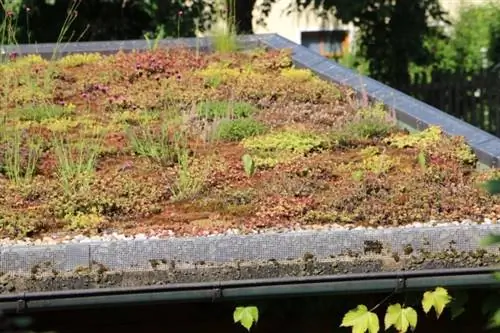
Green roofs can often save a lot of money, as they absorb part of the precipitation and the municipalities therefore deduct the greened area as a percentage of the total area. However, you can avoid the fee entirely if your property is not connected to the sewage system or you install a cistern to collect rainwater.
Tip:
Caution is also advised when building a pond, because, depending on the municipality, this can also be counted as a paved area.
Frequently asked questions
What is considered an unsealed area?
All green and lawn areas are considered unsealed, as are planted ornamental and useful plant beds and fallow soil. On the other hand, materials that allow some of the rainwater to seep through are considered to be poorly sealed (and therefore usually count as a small proportion of the rainwater fee). These include, for example, sand and gravel areas, lawn paving stones, lawn joint paving, gravel ceilings, wooden gratings and paving.
Why is the amount of precipitation introduced not taken into account?
Quite simple: To do this, the amount of rainwater discharged into the sewerage system would have to be measured somehow, which, however, involves immense effort and cannot be carried out without errors. Since this effort would lead to a significant increase in the price of the fee, the authorities have agreed on this form of calculation.

